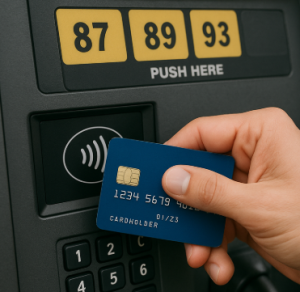Virtual Cards: A Safer Future for Digital Payments
According to a recent article released by PYMNTS, Mastercard has launched “widescale global availability” of an enhanced automated virtual card solution named Mastercard Receivables Manager. New proficiencies in securing card-on-file data and multi-language aid in supporting the digital commerce processes around the world.
As B2B digital payments grow in popularity, exciting news such as Mastercard's announcement of advancements in securely transmitting credit card data will benefit all consumers. The PYMNTS Intelligence report, “Digital Payments Evolution: Virtual Cards Poised to Take Off,” found that 42% of consumers in the United States had used a virtual card for online purchases and subscriptions. The report continues to state that more than half of U.S. consumers store a minimum of one card in digital wallets such as Apple Pay or Google Wallet.
Is a virtual card the same number as my physical card?
Short answer - no. A virtual card has its unique 16-digit number, expiration date, and CVV that is linked to your actual card or bank account. Therefore, the virtual card acts as a secure proxy, keeping your actual account details hidden from merchants or potential hackers.
How does it create a more secure transaction?
Many virtual cards reduce potential fraud by setting limitations against unauthorized use. Customizable controls enable consumers to create single-use, multi-use, or merchant-specific cards, depending on the issuer and the intended purpose. Setting preferences such as spending limits, expiration dates, and merchant restrictions will add another layer of security.
What happens if the information is compromised?
The consumer can cancel or generate a new number instantly, without replacing their physical card. Similar to tokenization, the actual cardholder's account number is encrypted, which means no actual card data is transmitted.
How do consumers create a virtual card?
Many major banks, credit card companies, and third-party apps offer virtual cards. Log in to your bank or card issuer account via a website or mobile app and navigate to the “card controls” section, set preferences, and select “Generate”. Use this number as the credit card information for online purchases and subscriptions.
Apps like Privacy.com, Revolut, Venmo Credit, and Apple Card allow you to link your funding source (bank account or card). Choose options such as one-time use or reusable. Copy the card details and use them during checkout.
In conclusion, as the shift toward digital payments accelerates, virtual cards are proving to be a powerful tool for secure, flexible, and efficient transactions. With major players like Mastercard leading innovation in this space, both businesses and consumers stand to benefit from enhanced fraud protection and greater control over how payments are made and managed. Whether for online purchases, subscriptions, or B2B transactions, virtual cards are shaping the future of secure commerce.
Are Tap-to-Pay Stickers at Gas Pumps a Scam?
Here’s What You Should Know.

Every day, scammers devise new ways to trick consumers. With constant text messages, social media posts, and viral videos fueling fear, it’s challenging to separate fact from fiction. A recent video circulating online sparks concerns about tap-to-pay stickers at gas stations. For years, experts have warned consumers about fraud tactics, such as skimming devices hidden in card readers.
A key tip: check the tamper-evident seal on the pump. If the seal is broken or missing, the pump may have been compromised.
What about the focus on the sticker itself?
According to Google’s AI Overview,
“Stickers placed over tap-to-pay devices at gas pumps are generally legitimate, not a scam. They are often replacement stickers used by gas stations to maintain visibility of payment options, not to steal data. While the circulation of these stickers online has sparked fears of a scam, officials have clarified that the stickers are typically standard industry replacements for worn-out or damaged terminals.”
In other words, most of these stickers are harmless. However, if you notice the tap-to-pay option isn’t working, and the chip reader also fails, it’s best to go inside the store to complete your transaction. Avoid swiping your card, as the magnetic stripe is more vulnerable to skimming devices.
Red Flags: Watch out for stickers promoting a QR code or mobile payment apps, such as Venmo. They are not part of standard pump hardware and should be reported to the station attendant immediately.
Is tap-to-pay the safest option?
Yes. A recent ATMIA (ATM Industry Association) article cited the Financial Crimes Intelligence Center (FCIC) in Tyler, Texas, confirming:
“While we all need to stay vigilant as criminals become more savvy, there are no legitimate instances reported where ‘tap-to-pay stickers’ have been used to steal data,” said Jeff Roberts, FCIC Intelligence Operations Captain.” The article continues to say "tap-to-pay option at fuel pumps, especially when using a payment app, remains the safest method.”
Here's why: Tap-to-pay cards use a small chip and antenna to communicate with payment terminals using radio frequency identification (RFID) or near-field communication (NFC) technology. These systems don’t transmit the actual cardholder’s account number. Instead, they use tokenization, which turns sensitive data into a unique, encrypted code that protects your information during wireless transmission. This makes tap-to-pay one of the most secure payment methods available.
The bottom line.
In today’s digital world, where misinformation spreads quickly, staying informed and cautious is your best defense.
-
Learn how tap-to-pay works
-
Inspect the pump before paying
-
Avoid using the magnetic stripe
-
Report anything that seems off
Stay smart, stay secure!
Have questions about secure payment options? Contact us today.
Follow us for more payment safety tips and share this article to help others pump with confidence.
CCG is Your Best Source for FirstData Clover POS Systems
When it comes to all-in-one retail systems that you can quickly set up, take payments, and manage just about all of your customer and employee needs, we’re pretty psyched about FirstData’s family of Clover point-of-sale (POS) systems.
Clover POS systems make running your business a breeze.
You can take orders and accept payments from just about anywhere, and you can accept every kind of credit, debit, and gift cards, as well as NFC and mobile wallets. Offer digital receipts and one-touch tipping. Easily process refunds, returns, and exchanges. Enable online ordering and contactless payments for faster, safer transactions and greater customer satisfaction. You can even set up automatic tax rates to be applied to all your sales.
Keep Customers Coming Back
In these days when it’s harder to make a real connection with customers, Clover systems help you get to know your customers better. Automatically generate customer profiles with contact info, birthdays, and order histories. Communicate with your customers privately and get firsthand feedback on their experience quickly and privately. Make announcements, send custom promotions, and marketing campaigns via email, text, or the Clover app.
Oversee Your Whole Staff
When it comes to managing your staff, Clover systems let you anticipate busy times on a daily, weekly, or monthly basis so you can manage shifts and schedules. Set individual employee permissions based on your team’s structure and responsibilities, and view employee sales, tips, and refunds so you keep on top of register activity. And since Clover doesn’t charge per employee, you can make it available to your whole team.
Why Use Commonwealth When Selecting a Clover POS System?
As a smart consumer, you may be wondering why you would purchase your Clover POS system through Commonwealth Consulting Group versus going direct with FirstData. We’re glad you asked! First and foremost, our costs are lower so we can most likely offer you better pricing on equipment, but there’s no replacing the prompt and knowledgeable local service we offer at CCG. We’re always available to walk you through the process of making sure you have the right system for your busy needs and that you are using the system you purchase effectively.
Have we piqued your interest? Give us a call at 800-866-3944 and we’ll be happy to help you find the Clover POS system that is perfect for your business.
What Are Mobile Payments and Why They’re a Good Thing
Apple Pay, Google Pay, and Samsung Pay are all mobile payment tools utilizing near field communications (NFC) technology. NFC has been around since the early 2000s but up until the last few years it hasn’t been a common way to make a payment. The adoption of chip based (EMV) credit and debit cards in the U.S. has forced most merchants to upgrade their payment acceptance hardware to allow for chip payments. In doing so, NFC capable devices became a lot more prevalent in the marketplace. Today, in the U.S., you can pay with a smartphone or smartwatch at most major retailers and at approximately half of all small businesses.
The mobile wallets behind Apple Pay, Google Pay, and Samsung Pay safeguard your payment information when you complete a transaction by utilizing a unique card ID every time. By doing this, it makes that card information useless to a thief or hacker as that card number was only good for that one transaction. This level of protection is a main driving force behind why consumers are using mobile payments more often. Secondly, not having to search for a card in your wallet or purse makes the payment transaction a lot more convenient.
In Europe, mobile payments have become much more common because public transportation systems are utilizing NFC based smartphone wallets for fares. Passengers who use smartphone wallets eliminate the need for paper or plastic cards and can add money to their public transportation wallet, for the system that they are utilizing, right through their phone instead of on a machine at each subway or train stop. As this type of technology comes to major cities in the U.S., there will likely be a significant increase in the use of mobile payments compared to taking out a physical card. It should also help reduce the overall operating costs for our various public transportation systems.
By combining technology with real world systems, mobile payments will make soon make transactions like riding the subway easier and help ensure consumer credit and debit card safety. This win-win scenario is a sign of things to come and a boon for business and consumers.




